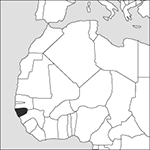
Capital:
Bissau
Area:
36,125 sq km (13,948 sq miles)
Population:
1,660,870 (2013 est)
Currency:
1 CFA Franc=100 centimes
Religions:
Muslim 50.0%; traditional beliefs 40.0%; Christian 10.0%
Ethnic Groups:
Balanta 30.0%; Fula 20.0%; Manjaca 14.0%; Mandinga 13.0%; Papel 7.0%
Languages:
Portuguese (official); creole; local languages
International Organizations:
UN; AU; Non-Aligned Movement; ECOWAS; Franc Zone; WTO
A small tropical country on the coast of West Africa, bounded by Senegal on the north and Guinea on the south. Offshore is the Bijagós archipelago with a score of inhabitable marshy islands.
Physical
The deeply indented coast of Guinea-Bissau, stretching for some 240 km (150 miles) from north to south, is marshy and contains the mouths of three major rivers. The interior, which extends eastward for some 300 km (185 miles), consists mainly of river valleys filled with rainforest; it rises to above 200 m (650 feet) only in the south.
Economy
Guinea-Bissau is a poor country with a mainly agricultural economy whose significant exports are fish, cashews, groundnuts, and palm kernels.
History
Portuguese explorers and traders were active around the coast from the mid-15th century, developing the area into a centre of the slave trade. First incorporated as part of the Portuguese Cape Verde Islands, it became the separate colony of Portuguese Guinea in 1879. Its boundaries were fixed by the 1886 convention with France. In the 1960s a movement for liberation from colonial rule emerged and grew under the leadership of Amilcar Cabral, and in 1974 Portugal formally recognized its independence. In 1977 an unsuccessful attempt was made to unite with Cape Verde (a newly formed republic of islands to the west). In 1980 a military coup established a revolutionary council with João Vieira as President and a National Assembly elected from the ruling Marxist party, the PAIGC. In 1989 Vieira was re-elected and in 1991 the National Assembly agreed to the introduction of multiparty democracy. The country’s first multiparty elections, in 1994, were won by the ruling party and Vieira was re-elected President. An attempted coup in 1998 was suppressed but violence continued and Vieira was overthrown by a military coup in 1999. Civilian rule was restored in 2000, but was ended by another coup in 2003. Presidential elections were held in 2005, when Vieira was returned to power; he was assassinated in 2009. The following years saw military unrest; there was at least one attempted coup and claims that more had been foiled. A coup succeeded in 2012, but after international pressure the civilian Manuel Serifo Nhamadjo was named President of a transitional government. Elections were called in 2014 and won by José Mário Vaz of the PAIGC, who faced the entrenched problems of corruption and controlling the cocaine trade (the country had become a staging post from Colombia to Europe). Vaz soon fell out with his own party and there has since been chronic instability, with five different prime ministers in two years.
- rationality
- rationalization
- rationalize
- rationalized MKS system
- rationalized Planck constant
- rationalized units
- rational language
- rational number
- rational reconstruction
- rational type
- rationing
- ratio scale
- ratio test
- Ratitae
- rat-race
- rattlesnake
- Raukumara
- Raunkiaer, Christen
- Raup, David Malcolm
- RAVAN
- raven
- ravens, paradox of
- Ravenstein’s ‘laws’ of migration
- ravinement surface
- ravine wind